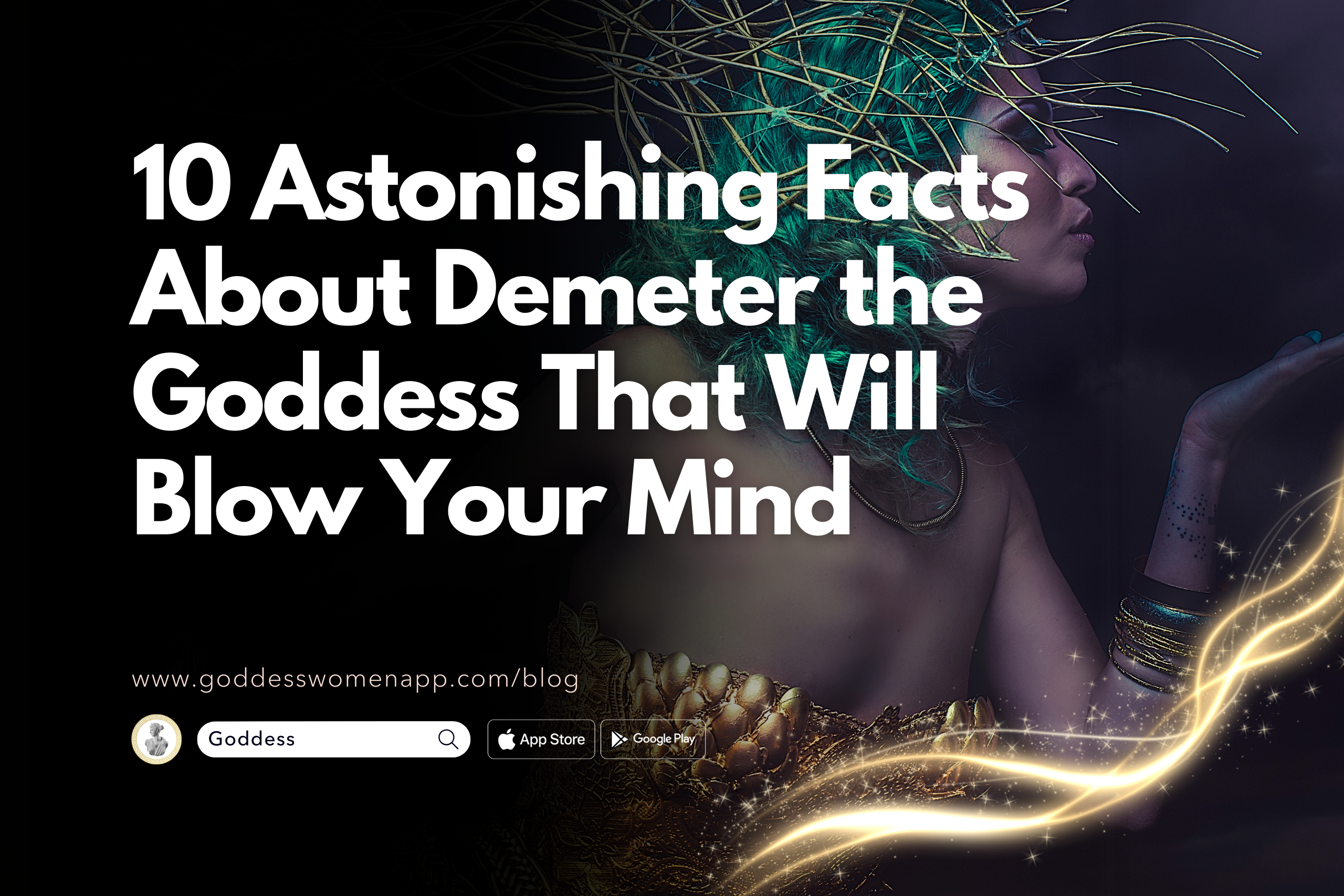Table of Contents
Introduction
In the vast and intricate tapestry of Greek mythology, there are tales that captivate, legends that intrigue, and deities that hold the power to influence the very fabric of existence. Among these divine figures stands Demeter the Goddess, a central figure whose story weaves through the cycles of life, death, and rebirth. As the goddess of harvest, agriculture, and fertility, her narratives are not just myths; they are reflections of the natural world and the human condition.
From the Eleusinian Mysteries to her unyielding love for her daughter Persephone, Demeter’s tales are as rich as the earth she blesses. Join us as we unearth “10 Astonishing Facts About Demeter the Goddess That Will Blow Your Mind,” delving deep into the heart of ancient rituals, undying maternal love, and the secrets that have influenced civilizations.

Who is Demeter the Goddess?
In the pantheon of Greek mythology, Demeter holds a place of honor as the goddess who presides over grain, the fertility of the earth, and the cycle of life and death. Her name weaves through the ancient world, synonymous with the nurturing force that sustains humanity. Yet, Demeter is perhaps most renowned for her profound connection with the Eleusinian Mysteries, secretive rites that promised initiates a closer communion with the divine and hopes of life beyond death.
Central to Demeter’s mythology is her beloved daughter Persephone, mature woman whose fate becomes inexorably linked with the rhythms of the natural world. The tale of Persephone’s abduction by Hades and Demeter’s subsequent grief paints a poignant picture of a mother’s love and the lengths to which she will go to protect her child. This story is not only a cornerstone of Greek mythology but also a foundational myth explaining the changing seasons and the cycle of life, death, and rebirth that governs the natural world.
Demeter’s influence extends far beyond the grains that sprout from the earth and the mysteries shrouded in secrecy. She embodies the maternal aspect of nature itself—nurturing, providing, and fiercely protective. In exploring the depth of Demeter’s character and her role within Greek mythology, we uncover not just the stories of a goddess but the universal themes of life, loss, and love that resonate across time.
The Birth of Demeter the Goddess
In the heart of Greek mythology, where gods and goddesses roam the heights of Mount Olympus and the depths of the human imagination, the story of Demeter, the goddess of the harvest and agriculture, begins. Born to the Titans Rhea and Cronus, Demeter emerged into the pantheon as a deity intrinsically tied to the cycles of nature and the sustenance of mortal life. Her story, deeply embedded in the ancient Greek culture, unfolds through sacred texts and Homeric hymns, offering glimpses into the divine essence that governs growth and fertility across the Earth.
As the patron goddess of the sacred law and the mysteries that bind the earth to the heavens, Demeter’s narrative is irrevocably linked with the Eleusinian Mysteries, secret rites performed in the city of Eleusis. These mysteries, shrouded in secrecy, celebrated the cycle of life and death, a theme recurrent in Demeter’s own tale of loss and reunion with her daughter, Persephone. The Eleusinian Mysteries drew countless ancient Greeks, seeking understanding and communion with the divine forces governing life’s perpetual renewal.
The mythology of Demeter and her daughter Persephone is a cornerstone of ancient Greek religious practice. Persephone’s abduction by Hades, the god of the underworld, and Demeter’s ensuing search, highlight the unbreakable bond between mother and child, echoing the natural world’s resilience. As Demeter searched the earth for her lost daughter, the world experienced its first winter, her grief halting the growth of all plant life. It was only upon Persephone’s return, a negotiation marked by the consumption of pomegranate seeds, that the earth flourished once more. This cycle of departure and return was not only central to the myth of Demeter and Persephone but also to the ancient Greeks’ understanding of the seasons and the agricultural cycle.
Demeter’s profound connection with the earth and its bounty is symbolized through her sacred groves, flaming torches, and the grain sheaf, underscoring her role as the goddess of agriculture. Her influence extended to the very core of ancient Greek society, shaping rituals and customs centered around farming and the harvest. The Homeric Hymn to Demeter, one of the oldest and most revered sacred texts, encapsulates the essence of Demeter’s power and her pivotal role in ancient history, revealing the depth of her character as both a nurturing mother and a formidable goddess.
In ancient Greece, Demeter was venerated not just as the grain mother but as a representation of the insatiable hunger of the human race for knowledge and understanding of the divine. Her mysteries, though now part of ancient history, continue to fascinate and inspire, a testament to the enduring legacy of Demeter, the goddess of the harvest, and her daughter Persephone, in the tapestry of human culture. Through the myth of Demeter and Persephone, the ancient Greeks explored themes of life, death, and rebirth, embedding the natural world’s rhythms into their understanding of the divine and the sacred connection between the earth and the cosmos.
In the lush narratives of Greek mythology, woven into the very fabric of ancient Greek culture, Demeter the Goddess emerges as a figure of immense importance. As the goddess of agriculture, fertility, and the sanctity of the earth, her story is a cornerstone of the ancient world’s belief system. Born to Rhea and Cronus, Demeter’s arrival into the pantheon of Olympian gods marked a pivotal moment in the celestial hierarchy. She wasn’t just another deity; she was the embodiment of the earth’s bounty, a patron goddess who nurtured mankind with the gifts of the harvest.
Demeter’s narrative is inseparably linked to her daughter Persephone, whose abduction by Hades, the god of the underworld, unveils the depth of a mother’s love and the cyclical nature of life and death. This myth, captured eloquently in the Homeric Hymn to Demeter, not only explains the changing seasons but also forms the basis of the Eleusinian Mysteries, secretive rites that promised initiates deeper understanding and a closer connection to the divine.
These secret rites, held in the city of Eleusis, were fundamental to ancient Greek religion, embodying the sacred law and the mysteries of life, death, and rebirth. The Eleusinian Mysteries celebrated the return of Persephone to the earth’s surface, a joyous occasion that symbolized the rebirth of plant life and the end of the dry Mediterranean summer. This cycle of life, death, and renewal was central to the worship of Demeter and Persephone, encapsulating the essence of their divine roles.
Demeter, in her endless search for Persephone, traversed the earth, her journey reflecting the insatiable hunger of the human race for unity and understanding. The pomegranate seeds Persephone consumed in the underworld, binding her to return for a portion of each year, symbolize the inextricable link between life and death, light and darkness, the mother earth and the eternal bond between mother and daughter. This myth, steeped in ancient history, highlights the profound impact of Demeter and Persephone on the ancient Greeks’ conceptualization of the natural world and the afterlife.
The sacred groves of Demeter, her flaming torches, and the grain sheaf are enduring symbols of her dominion over agriculture and fertility. These symbols, alongside the sacred animals associated with the two goddesses, underscore the reverence in which Demeter was held as the goddess of the harvest. Her influence extended across ancient Greece, from the secret rites at Eleusis to the sacred texts that chronicled her deeds, shaping the spiritual and daily life of the ancient Greeks.
Demeter’s relationship with her youngest brother Zeus, also Persephone’s father, adds another layer to her mythological narrative. It was Zeus who brokered the agreement with Hades, allowing Persephone to return to her mother for part of the year, thereby reinstating Demeter’s joy and the fertility of the earth. This intricate web of relationships among the Olympian gods underscores the complex dynamics of power, loyalty, and love that define Greek mythology.
In every myth, Homeric hymn, and ancient artifact, from the British Museum to the Metropolitan Museum, the story of Demeter and Persephone unfolds, revealing the ancient Greeks’ deep connection to the earth, the divine, and the mysteries that govern life and death. Their story, a testament to motherhood, resilience, and the cycles of nature, continues to fascinate and inspire, a timeless narrative of the power of the divine feminine in ancient history and beyond.

The Power of Demeter the Goddess
In the pantheon of ancient Greek mythology, Demeter the Goddess stands as a formidable figure of maternal strength and the divine patroness of the earth’s bounty. Her power, deeply rooted in the life-giving aspects of nature, underscores her significance as the goddess of agriculture, fertility, and the sacred law that governs the cycles of life and death. This profound connection to the earth and its inhabitants is celebrated through the Eleusinian Mysteries, secret rites that encapsulated the essence of Demeter’s power and her indelible bond with her daughter Persephone.
Demeter’s authority extends beyond the mere cultivation of crops and into the very heart of ancient Greek culture. As the grain mother, her gifts to humanity were not just the wheat and the barley that fed the ancient Greeks but the sacred knowledge of agriculture that allowed civilizations to flourish. The Homeric Hymn to Demeter, a sacred text revered throughout ancient Greece, paints a vivid picture of her relentless search for Persephone following her abduction by Hades, god of the underworld. This tale symbolizes the eternal cycle of death and rebirth, a core tenet of the mystery cult devoted to Demeter and Persephone.
The mythological narrative of Demeter’s search and Persephone’s separation and reunion is emblematic of the changing seasons, from the barrenness of winter, when Persephone resides in the underworld, to the fertility of spring and summer, heralded by her return to the earth’s surface. This cycle reflects Demeter’s unparalleled dominion over plant life and her ability to dictate the seasons, an aspect of her power that resonated deeply with the agricultural society of ancient Greece.
Demeter’s sacred groves and her association with sacred animals, such as the serpent and the pig, further attest to her wide-reaching influence over the natural world. Within these sacred spaces, ancient Greeks performed rites and offered sacrifices to honor the goddess and seek her blessings for bountiful harvests and the prosperity of their communities.
The pomegranate seed, a seemingly insignificant object, symbolizes the depth of Demeter’s power and the complexity of her character. By allowing Persephone to consume the pomegranate seeds, Hades ensured her return to the underworld for part of each year, a compromise brokered by Zeus, Demeter’s youngest brother and Persephone’s father. This act, which binds the goddess of the harvest to the god of the dead, illustrates the interconnectedness of life and death, fertility and barrenness, and the balance maintained by Demeter’s hand.
As the ancient Greeks looked to the heavens and the earth to understand the forces that shaped their world, Demeter appeared as a beacon of maternal strength, a provider of life’s essentials, and a guide through the mysteries of existence.
Her influence, encapsulated in ancient history, secret rites, and the sacred texts that celebrate her deeds, continues to be a testament to the enduring power of the goddess of agriculture in the tapestry of human belief and the natural world. Through the myths of Demeter and Persephone, the ancient Greeks explored the fundamental truths of their existence, celebrating the cycles of nature and the divine providence that sustains the human race.

Demeter the Goddess and the Eleusinian Mysteries
Within the heart of ancient Greek culture lies the enigmatic and profound connection between Demeter the Goddess, the revered goddess of agriculture and the harvest, and the Eleusinian Mysteries, secret rites that held a place of utmost significance in the spiritual landscape of ancient Greece. These mysteries, centered in the town of Eleusis, embodied the sacred law and the deep-rooted beliefs of the ancient Greeks, offering initiates a closer communion with other gods and the divine and promising them hope for life after death.
The Eleusinian Mysteries were intricately tied to the myth of Demeter and her beloved daughter Persephone, whose story is a poignant narrative of loss, search, and reunion. Following Persephone’s abduction by Hades, god of the underworld, Demeter’s grief plunged the earth into a barren state, halting the cycle of life and growth. Her relentless search for Persephone underscored her unwavering maternal bond and her role as the patron goddess not just of the harvest but of the unbreakable ties between mother and child.
As the ancient hymns recount, Demeter arrived in Eleusis, disguised as an old woman, her divine identity hidden from mortal eyes. Here, amidst gathering flowers in the sacred groves and the flaming torches that pierced the darkness, the goddess revealed the secret rites of the Eleusinian Mysteries. These rites symbolized the cycles of death and rebirth, mirroring the seasonal changes of the earth itself and reflecting the profound spiritual beliefs of the ancient Greeks.
The Unbreakable Bond Between Demeter and Her Daughter Persephone
The core of the Eleusinian Mysteries, and indeed of Demeter’s myth, is the unbreakable bond between the goddess Demeter herself and Persephone. This bond transcends the mere relationship between mother and daughter, embodying the cycle of life and the inevitability of death and rebirth. Persephone’s return from the underworld, facilitated by the pomegranate seeds she consumed—a symbol of her bond to Hades and the cyclical nature of her existence—brings about the rejuvenation of the earth and the return of fertility and growth.
This narrative, celebrated through the Homeric Hymn to Demeter, not only reflects the ancient Greeks’ understanding of the natural world but also their beliefs about the afterlife and the soul’s journey. It was Demeter’s love for Persephone that led to the establishment of the sacred laws and the mystery cult, which promised initiates a deeper understanding of life’s mysteries and the promise of rebirth after death.
The mythology of Demeter and Persephone, rich with themes of love, loss, and the eternal cycle of life, resonates through the ages, symbolizing the indomitable spirit of the earth and the enduring power of maternal love. Their story, embedded in the heart of ancient Greek mythology and celebrated through the Eleusinian Mysteries, remains a powerful testament to the depth of the human experience and the ancient Greeks’ quest for understanding the divine forces that shape our world.
In the sacred texts and the rituals of Eleusis, in the sacred groves where Demeter once walked, and in the hearts of those who followed the flaming torches into the mystery, the tales of these two goddesses continue to inspire and illuminate. The bond between Demeter and Persephone, forged in the depths of the underworld and celebrated in the fields of Greece, stands as a timeless symbol of renewal, resilience, and the unbreakable connections that bind the cosmos.

Demeter the Goddess’s Wrath: The Cause of Winter
The tale of Demeter, the goddess of the harvest and agriculture, is woven deeply into the fabric of Greek mythology, illustrating not only the depths of a mother’s love but also the profound impact of divine emotion on the natural world. Demeter’s wrath, a pivotal element of the mythological narrative, arises from the abduction of her beloved daughter Persephone by Hades, the god of the underworld. This event plunges Demeter into a grief so profound that it manifests as the first winter on Earth, a season of death and barrenness that mirrored her own desolation.
As Demeter searched the earth for Persephone, her sorrow withheld the gifts of fertility and growth from the human race. The once bountiful fields lay fallow, crops failed to grow, and famine threatened the very survival of mankind. This period of darkness and cold, which recurs annually, serves as a poignant reminder of Demeter’s despair and the consequences of her wrath. It was only the return of Persephone, brokered by Zeus, Demeter’s youngest brother and the king of the Olympian gods, that tempered her anger and brought about the renewal of spring and the return of abundance to the earth.
This cyclical tale of loss and reunion, rooted in the Eleusinian Mysteries and celebrated in the Homeric Hymn to Demeter, embodies the ancient Greeks’ understanding of the seasons and the natural balance. Demeter’s wrath and subsequent forgiveness illustrate the interconnectedness of divine will and the mortal world, offering a mythological explanation for the changing seasons that so deeply affected agricultural societies.
The Sacred Symbols of Demeter the Goddess
In the rich tapestry of Greek mythology, symbols carry deep meanings, connecting the gods and goddesses to their divine powers and the earthly realms they govern. For Demeter, the goddess of the harvest, several sacred symbols underscore her significance in ancient Greek culture and religion. The grain sheaf, representing fertility and the bountiful gifts of the earth, is perhaps the most iconic symbol associated with Demeter, embodying her role as the patroness of agriculture and the sustainer of life.
Flaming torches, another symbol closely linked with Demeter, evoke her relentless search for Persephone, piercing the darkness with light and hope. These torches not only signify Demeter’s determination and unwavering love but also illuminate the path for the initiates of the Eleusinian Mysteries, guiding them through the secret rites that promised understanding and rebirth.
Pomegranate seeds, the fruit that bound Persephone to the underworld and symbolized her dual role as the queen of the underworld and the embodiment of spring’s return, serve as a poignant emblem of life, death, and the eternal cycle of renewal. The consumption of these seeds by Persephone is a critical moment in the myth, encapsulating the complexities of her relationship with both Demeter and Hades.
Sacred animals also play a role in the iconography of Demeter, with the serpent and the pig featuring prominently in rituals and offerings. The serpent, a symbol of renewal and the cyclical nature of life, reflects the themes of death and rebirth inherent in Demeter’s mythology. The pig, an animal sacrificed in the Eleusinian Mysteries, symbolizes fertility and the abundance of the earth, further linking Demeter to the cycles of growth and harvest.
Together, these sacred symbols form a rich visual and thematic vocabulary that celebrates Demeter’s powers, her deep connections to the natural world, and her central role in ancient Greek religion and culture. Through these symbols, the ancient Greeks expressed their reverence for Demeter, recognizing her as a key deity in their pantheon and a divine force that nurtured and sustained their connection to the earth and its cycles.

Demeter the Goddess’s Temples and Sanctuaries
The reverence for Demeter the Goddess, the deity of harvest and agriculture, permeated ancient Greek culture, giving rise to the construction of numerous temples and sanctuaries dedicated to her worship. Central to her veneration were the Eleusinian Mysteries, held in Eleusis, which stood as a significant site where secret rites were performed to honor the sacred bond between Demeter and her daughter Persephone. These mysteries encapsulated the essence of ancient Greek religious practice, offering initiates a deeper understanding of life, death, and rebirth, reflective of Demeter’s cycle of loss and reunion with Persephone.
Among the many sanctuaries, the Telesterion in Eleusis was paramount. It was here that the most sacred rituals were conducted, enveloped in secrecy and accessible only to those who had been initiated. The site, like Demeter’s other temples, was often surrounded by sacred groves and altars where the ancient Greeks performed rituals and offered sacrifices, seeking the goddess’s blessings for fertility and a bountiful harvest.
These sacred spaces were not mere places of worship; they were integral to the community’s survival, embodying the deep connection between the ancient Greeks and the cycles of nature Demeter governed. Through these temples and sanctaries, devotees could engage directly with the divine, ensuring the continued favor of Demeter and the prosperity of their lands.
Demeter the Goddess in Art and Culture
Demeter’s influence extended well beyond the confines of her temples, deeply embedding herself within ancient Greek art and culture. She was frequently depicted in various forms of art, from the majestic sculptures that captured her divine essence to the vase paintings illustrating her myths, particularly the abduction of Persephone and the ensuing changes on Earth.
The Homeric Hymn to Demeter, one of the oldest known sacred texts, poetically narrates the story of Persephone’s abduction and Demeter’s grief-stricken search. This hymn, and other literary works like it, played a crucial role in spreading the goddess’s tales across ancient Greece, cementing her status as a central figure in Greek mythology.
In sculptures and paintings, Demeter was often portrayed as a mature woman, embodying the attributes of fertility, motherhood, and the harvest. She might be seen holding a sheaf of wheat or a torch — symbols of her dominion over agriculture and her tireless search for Persephone. Notable examples of her depiction can be found in the British Museum and the Metropolitan Museum, where artifacts continue to offer insights into her worship and the cultural significance she held.

Understanding Greek Mythology Through Demeter the Goddess
The myth of Demeter and Persephone serves as a cornerstone for understanding Greek mythology and ancient Greek culture. Through Demeter’s story, one gains insights into the ancient Greeks’ worldview, their perceptions of the divine, and the natural cycles that governed their lives. The mother-daughter relationship, central to Demeter’s myth, underscores themes of love, loss, and the immutable cycle of seasons — reflecting the human condition itself.
The Eleusinian Mysteries, rooted in Demeter’s narrative, highlight the spiritual depth of Greek mythology, offering a glimpse into the ancient Greeks’ quest for meaning beyond the physical world. These secret rites, promising initiates a deeper understanding of life’s mysteries, underscore the importance of Demeter and Persephone’s myth in the broader context of Greek religious beliefs.
Through Demeter, ancient Greek culture articulated its understanding of life’s cyclical nature, the inevitability of change, and the hope for renewal. Her worship, deeply intertwined with the fabric of daily life, offered the ancient Greeks not just agricultural prosperity but spiritual nourishment, tying them to the eternal dance of the seasons and the perpetual cycle of life and death.
In exploring Demeter’s temples, her portrayal in art, and the myths that surround her, one uncovers the layers of meaning that she brought to the ancient Greeks — as a goddess, a protector, and a guide through the mysteries of existence. Demeter’s enduring legacy in Greek mythology invites modern readers to reflect on the interconnectedness of life, the natural world, and the divine, offering timeless insights into the human experience.
The Eleusinian Mysteries Revisited
The Eleusinian Mysteries stand as one of the most intriguing and enduring aspects of ancient Greek religion, centered around the worship of Demeter and Persephone. These secret rites were held in Eleusis and offered initiates deeper spiritual insights into the mysteries of life, death, and rebirth, mirroring the agricultural cycle of the seasons governed by Demeter.
Rooted in the myth of Persephone’s abduction by Hades and her mother’s subsequent quest, the mysteries encapsulated the themes of loss, search, and reunion, reflecting the human experience and the natural world’s cyclical nature. The Eleusinian Mysteries, shrouded in secrecy, promised participants a closer connection to the divine and hopes for life beyond death, emphasizing the sacred bond between mother and daughter and their influence on the fertile earth and the underworld.

Persephone: The Beloved Daughter of Demeter
Persephone’s role in Greek mythology cannot be overstated; as the beloved daughter of Demeter, her abduction by Hades instigates the changing seasons and underscores the themes of loss and reunion that are central to human existence. Persephone’s duality as both the queen of the underworld and the embodiment of spring’s return each year symbolizes the intersection of life and death, illustrating the ancient Greeks’ understanding of the world’s inherent cycles. Her story, deeply woven into the fabric of Greek mythology, resonates with the universal experiences of grief, love, and the eventual acceptance of life’s transient nature, making her a relatable figure to the ancients and a compelling deity in the pantheon.
The Dual Life of Demeter’s Daughter Persephone
The myth of Persephone is a tale of contrasts and duality, portraying her as both the innocent maiden of spring and the somber queen of the underworld. This dual life reflects the ancient Greeks’ views on the afterlife and the cycles of nature. Each year, her descent into the underworld marks the beginning of winter, her stay with Hades symbolizing death and dormancy. In contrast, her return to the surface world heralds the arrival of spring, a time of rebirth and renewed life. This cyclical process governed by Persephone’s comings and goings offered the ancient Greeks a mythological explanation for the changing seasons and highlighted the balance between light and darkness, life and death.
The Cult of Demeter and Persephone in Ancient Greece
The cult of Demeter and Persephone was central to ancient Greek religious life, particularly in the celebration of the Eleusinian Mysteries. This cult emphasized the cycle of life and death and the promise of rebirth, concepts that were integral to agricultural societies dependent on the seasons’ ebb and flow. The rituals and ceremonies associated with their worship reinforced the communal bonds among participants and connected them to the divine, ensuring the fertility of the land and the continuation of life. Through the cult of Demeter and Persephone, the ancient Greeks expressed their reverence for the natural world and the gods who governed it, celebrating the profound connections between the earth, the divine, and the human community.
Conclusion
As we reflect on the enduring legacy of Demeter and Persephone, we are reminded of the power of myth to convey deep truths about the human condition, our relationship with the natural world, and the divine forces that shape our existence. Their myths, celebrating life’s resilience and the hope for renewal, continue to inspire and resonate, offering wisdom and guidance through the ages.
Are you moved by the unbreakable bond between Demeter and Persephone? Do you find yourself drawn to the themes of nurturing, growth, and the cycles of life and death? Perhaps there’s a part of you that resonates with the characteristics of Demeter, the goddess of the harvest, or Persephone, the queen of the underworld and symbol of renewal.
Discover your divine archetype by taking the Goddess Archetype Test on the Goddess App. Find out if you share the characteristics of Demeter, Persephone, or any of the other revered deities in Greek mythology. Embrace the wisdom of the ancients and connect with the divine aspects of your own nature. Take the test now and explore the depths of your spiritual heritage.
Embrace your inner deity and embark on a journey of self-discovery, guided by the timeless wisdom of Greek mythology.





